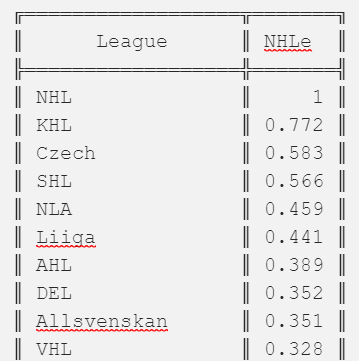Methodology
The methodology was simple: I wrote a program that pulled every single team's draft picks from 2007-2015 and put them alongside the players that
TopDownHockey's model would have picked instead, ranked by likelihood of becoming a star. The metric for performance was WAR (of TDH's model) accumulated over the next seven seasons after being drafted, and then summing them all up to figure out who would have acquired more WAR if they were the ones drafting: the team, or the model. Some disclaimers before we get into the actual results:
- The reason I went with the following seven seasons is because that seems to be the standard for evaluating draft picks. I don't know why it was settled on seven exactly, but it makes some sort of sense: generally, if you haven't made the NHL within your first seven seasons you're not going to be any player of note (I think the only exception that I found was Nick Jensen, but I wasn't hunting for them so I definitely could've missed a few). Anything beyond seven and it probably hinges more on development and the environment than drafting anyways.
- I picked 2007-2015 for the drafts because the data only goes back to 2007, and the seventh season for 2015 draftees is 2021-22, which is the last season we have up-to-date WAR data for (someone tell TDH to update his WAR table for 2022-23).
- I picked ranking by star likelihood because that's what TDH uses when he posts on his Twitter. No other reason, really.
- Some people will inevitably have reservations over picking WAR to determine NHL success. It's not ideal, but there's no real better metrics out there. Points unfairly punish defensemen and GP tells nothing about actual effectiveness in the NHL. Besides, TDH has demonstrated that WAR is generally a better metric for determining winning than points anyways, so it's the best we have. If you're still not satisfied with using WAR, I'll post the spreadsheet that I have so you can make your own judgments over who made the better picks anyways (It's formatted awfully though—I'll trust that you'll power through it).
- TDH doesn't rank goalies or overage players, so I didn't either. Picks used on goalies were simply taken out of the dataset. There wasn't an easy way to determine overage players with a program though, so I left them in. Consider it like a freebie for the teams if their overage player actually became an NHL contributor.
- Another pick taken out was NYR's pick used on Alexei Cherepanov in 2007, as he tragically died very young, and thus I didn't think that was fair to include him in NYR's dataset. For what it's worth, TDH's model would've picked him first overall.
- Any player that played NHL games but posted a negative WAR within their first seven seasons was set to 0 WAR, as I didn't want to punish teams for having their players play in the NHL, even if they were a net negative on their team. Any player that played NHL games was probably a better draft pick than me, even if I would've had more WAR just by virtue of not playing.
Data
I bolded all the teams that managed to outdraft NHLe.
| Team | WAR | NHLe WAR | Difference |
|---|
| Anaheim Ducks | 75.26248192 | 86.0578856 | 10.79540368 |
| Arizona Coyotes | 52.70552535 | 100.6280606 | 47.92253525 |
| Boston Bruins | 74.31326575 | 132.5093267 | 58.19606093 |
| Buffalo Sabres | 53.07765143 | 81.27886265 | 28.20121121 |
| Calgary Flames | 65.37393497 | 65.49411325 | 0.120178285 |
| Carolina Hurricanes | 78.17745991 | 94.85168494 | 16.67422503 |
| Chicago Blackhawks | 66.24949223 | 84.65136722 | 18.40187499 |
| Colorado Avalanche | 94.86944395 | 88.37525673 | 6.494187215 |
| Columbus Blue Jackets | 64.35772712 | 115.2004758 | 50.84274868 |
| Dallas Stars | 51.71521359 | 88.32291968 | 36.60770609 |
| Detroit Red Wings | 55.70576202 | 62.43467811 | 6.72891609 |
| Edmonton Oilers | 116.1647134 | 119.9187086 | 3.753995181 |
| Florida Panthers | 59.38695114 | 123.7786695 | 64.39171841 |
| Los Angeles Kings | 75.26115735 | 68.7038476 | 6.557309753 |
| Minnesota Wild | 58.96110164 | 68.69720687 | 9.73610523 |
| Montreal Canadiens | 45.95952079 | 68.56083485 | 22.60131406 |
| Nashville Predators | 69.58536049 | 80.73260342 | 11.14724293 |
| New Jersey Devils | 22.78388994 | 52.56784784 | 29.7839579 |
| New York Islanders | 81.273958 | 126.5243505 | 45.25039252 |
| New York Rangers | 41.78939637 | 37.26979607 | 4.519600298 |
| Ottawa Senators | 60.92148894 | 80.90309331 | 19.98160437 |
| Philadelphia Flyers | 43.4364581 | 53.59892426 | 10.16246616 |
| Pittsburgh Penguins | 36.22990234 | 60.32174721 | 24.09184487 |
| San Jose Sharks | 64.25186852 | 93.87956232 | 29.6276938 |
| St. Louis Blues | 77.45056404 | 101.9116382 | 24.46107412 |
| Tampa Bay Lightning | 113.515953 | 128.7486737 | 15.2327207 |
| Toronto Maple Leafs | 53.10183427 | 95.60597689 | 42.50414262 |
| Vancouver Canucks | 25.56315683 | 87.48578616 | 61.92262933 |
| Washington Capitals | 64.38664547 | 27.36114523 | 37.02550024 |
| Winnipeg Jets | 69.71173258 | 88.09308073 | 18.38134815 |
Results
Perhaps surprisingly, only 4 NHL teams managed to outdraft the model. I'll get into one later, but I'll explain what made the model prevail over everyone else for the people that don't want to go into the sheet to look for themselves.
The model followed a high ceiling, low floor philosophy. It especially had a propensity for taking KHL players that often went undrafted in reality. This made 2008 a uniquely bad year for the model: it had Filatov ranked second, an undrafted player named Dmitri Klopov 4th, Kirill Petrov, who was picked in the third round, 5th, and so on. 2008 was a year where the model posted a WAR number of 0 compared to the vast majority of teams.
However, when it hit on the Russian players, it hit
big. It ranked Tarasenko 1st and Panarin 8th in 2010, Kucherov 5th in 2011, and Kaprizov 8th in 2015. Those picks, along with players like Gaudreau (20th in 2011), Pastrnak (9th in 2014), Point (15th in 2014), and Kyle Connor (5th in 2015), is what allowed the model to pull ahead of most teams, even if it was actually much worse at picking players to make the NHL.

 I never said the model was even good. At no point. I posted someone's model about a Canucks prospect. I said I look at analytics as an easy way to look at progression on occasion. Then you few argued the validity of it. You asked for examples, I provided. If you don't like it, it's probably because you don't agree with it, not because it's wrong.
I never said the model was even good. At no point. I posted someone's model about a Canucks prospect. I said I look at analytics as an easy way to look at progression on occasion. Then you few argued the validity of it. You asked for examples, I provided. If you don't like it, it's probably because you don't agree with it, not because it's wrong.

